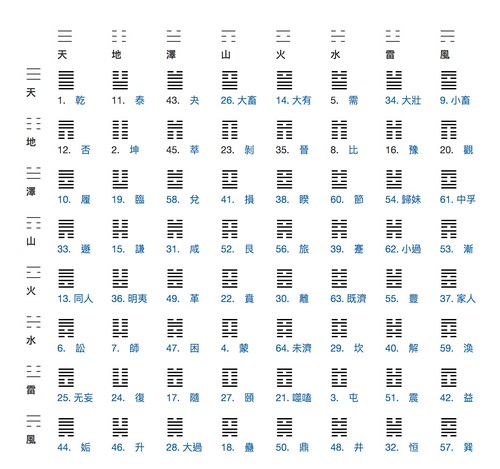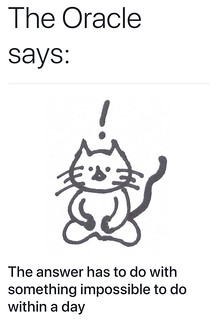Shower-omancy
I-Ching Master
1.Final Presentation
"I-Ching Master" is an oracle deck I created, where the querent uses their own sketch instead of flipping coins to get I-Ching hexagon results that tells their fortune or gives suggestion about their concerns.
The demo could be accessed at https://tongwu226.github.io/I-ChingRead/
2. Inspiration & Methodology

Traditional I-Ching divination consists of 64 hexagrams, composed of six stacked horizontal lines, where each line is either Yang or Yin decided by throwing three coins together for six times.
Literomancy is a form of fortune telling widely practiced in Chinese-speaking communities, where the querent asks the reader a question or tells a concern, then writes down a Chinese character. The reader tells the fortune or gives prediction on how to solve a question based on analyzing each single part of the character, or by adding strokes to or subtracking strokes from the original character to indicate potential change.
My oracle deck was just a clean, black box mimicing Fu, an important tool which is the symbol of Daoism practice, on which Daoist practitioners draw the incantation and make it function as summons or instructions to deities, spirits. An individual who participates in my divination practice could think about his/her concerns in mind, and then freely draws on the black canvas. The "Erase" button could clear the canvas if the participant is not satisfied with the drawing. Once done, he or she could press the "divination" button, which then generates four hexagram results from I-Ching based on the drawing. And the "read" button would generate content that explains what each hexagram result means, based on the traditional interpretation of I-Ching.
3. The Algorithm Behind

The algorithm behind this prototype is based on calculating the proportion of the pixels actually being painted in four different sections of the canvas, and mapping each of the four outcomes generated by the sketch to 16 hexagon results. Therefore, each drawing could generate four random results from 64 possible hexagon results.
4. Reference
Simple I-Ching hexagons illustration: http://www.eee-learning.com/article/2076 I-Ching hexagon result interpretations: http://divination.com/iching/lookup/12-2/Indecision Space - Ask Oracle to help you choose

Introduction
For the first meditation assignment, with Dan Oved as my collaborator, we created the Indecision Space, a mobile-friendly ritual accessed at http://indecision.space. This is an “electronic” ritual that visualizes the conflicting thoughts we usually have when making a decision and explores how human's minds are influenced by unrelated implication when making decisions. In the system to perform this ritual, the participant:- Thinks of something he/she feels undecided or worries about
- Holds his/her phone and waits patiently for 5 seconds for the results to come out
- Gets a sentence of "oracle" that suggests about decision making
Documentation of ITP students performing Indecider
Inspiration
The idea of Indecider came from our discussion about what part of our daily routine is worth transforming into an electronic ritual. We went from ideas that celebrates our "graduation" from a day of ITP, as many of us stay in ITP until pretty late, to posting on Facebook every single time someone solves a bug, then finally to Indecider. We want to write a small program that performs the role of the Oracle of Delphi, who is the High Priestess of the Temple of Apollo at Delphi that served as the oracle, that could let us know the "oracle" from program about our common life struggles.How it works:
The oracle is actually nothing but a sentence "the answer has to do with something ..." plus an adjective word picked from a database with about 300 common english adjective words. And to avoid stereotypes about "fortune telling" or "goddess", I sketched two cats, one for the "indecision" and the "undecided" pages with a question mark and one for the "oracle"page with an exclamation mark.We add a three-second waiting time before you can hit the button "Oracle, please help me choose" and a five-second pseudo-loading time for the oracle to show. Based on our own experience and our observation of others performing the ritual, proper amount of waiting time in a ritual raises people's interest in and attention on the results that's about to come out, and it helps to enhance the sense of the ritual.





